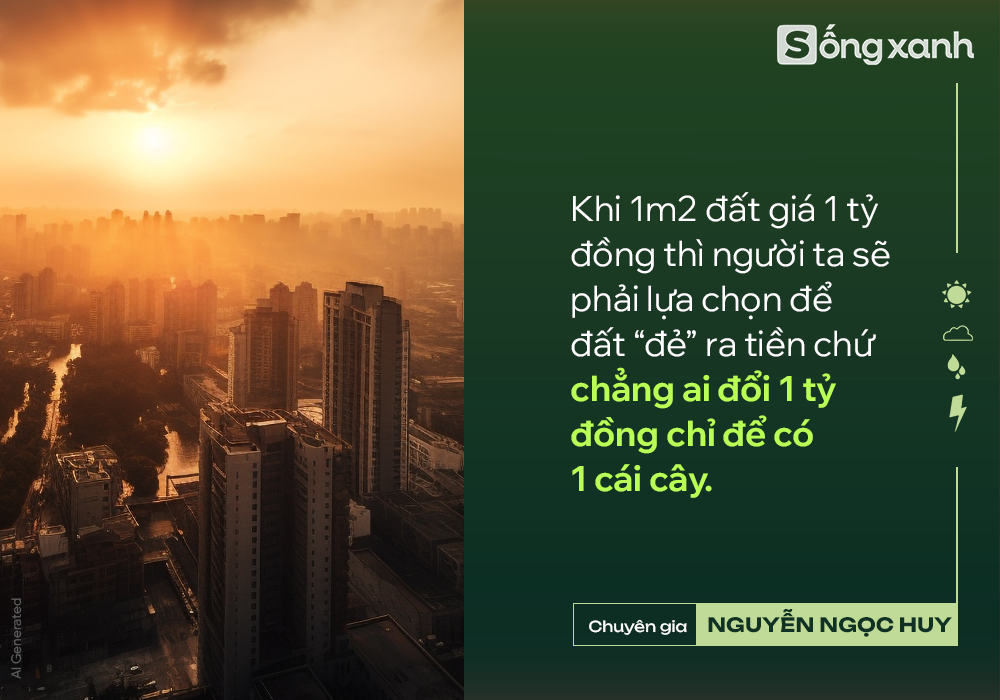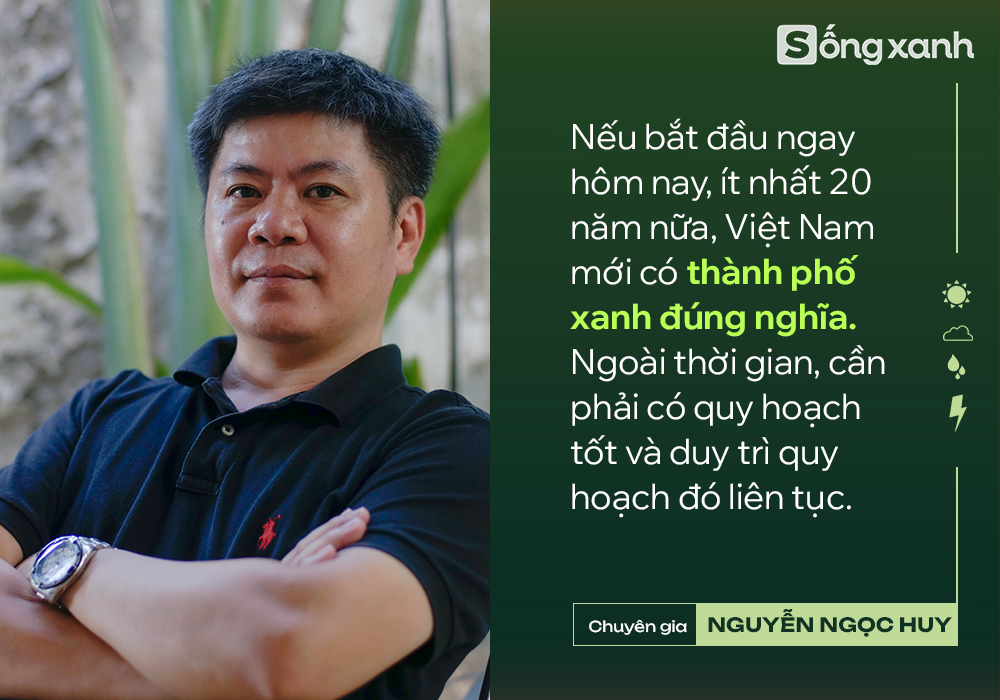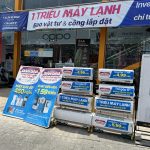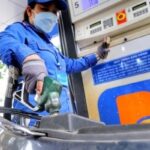Emissions from air conditioners not only increase short-term ambient temperatures but also raise greenhouse gas concentrations in the long run. In contrast, planting more trees to cool down naturally can lower ambient temperatures by 5-7 degrees Celsius compared to meteorological temperatures.
Weather expert Nguyen Ngoc Huy, known for his Facebook page Huy Nguyen, owns an apartment in a suburban area of Hanoi. There, during the hot summer noons, residents can still sit outdoors comfortably under the shade of the trees. For many people living in big cities, this might be a rare luxury due to the dense concrete landscape in the inner districts.

Complaining about the heat in the summer might sound funny, but on my way here at noon, I have to admit that I felt like I was being scorched by temperatures close to 50 degrees Celsius, not the forecasted 36 degrees.
Dr. Huy Nguyen: I understand completely. Since meteorological temperatures are measured in open, grassy areas, there can be discrepancies with actual temperatures depending on the location. For example, today’s forecast is 40 degrees Celsius, but in concrete-dominated areas, temperatures can soar to 45-47 degrees. In places with extensive concrete and heat-absorbing materials like roads, environmental temperatures can exceed meteorological temperatures by up to 10 degrees.
Hanoi’s hot season is harsh. Surrounded by high mountains to the west, such as Ba Vi, Vinh Phuc, and Hoa Binh, the capital city becomes a heat-trapping valley. During periods of strong hot low-pressure systems, Hanoi experiences limited vertical air circulation, causing meteorological temperatures to reach 40-41 degrees, and actual temperatures to climb to 47-48 degrees.

This phenomenon is called heat trapping because there is no vertical air exchange with the upper atmosphere. Today’s heat will be trapped, and tomorrow, with continued hot weather, the ground temperatures will rise even higher.
Unlike Ho Chi Minh City, Da Nang, or Nha Trang, which are coastal cities cooled by sea breezes, Hanoi is different. While you can feel a noticeable temperature drop when stepping into the shade in Saigon, Hanoi still feels scorching. We are subjected to ambient heat from the surrounding environment, not just direct sunlight.
Thank you for sharing this feeling. The oppressive heat is probably why air conditioners are installed in most buildings, despite many people being aware of their drawbacks.
Dr. Huy Nguyen: That’s right. Not only in Hanoi but also in Da Lat, a city known for its cool climate, the use of air conditioners has become prevalent over the past decade. While I don’t condemn the use of air conditioners, they indeed have several disadvantages. First, they consume a lot of electricity, which is costly in Vietnam. Second, their emissions contribute significantly to greenhouse gas concentrations in the atmosphere. Third, while cooling a room, they simultaneously expel hot air. Standing near the outdoor unit can be extremely uncomfortable. In a city filled with millions of these units, the collective heat output can raise temperatures by 3-5 degrees compared to meteorological readings.
According to the International Institute of Refrigeration (IIR) in 2019, the refrigeration and air conditioning sector consumes about 20% of global electricity and emits approximately 4.14 billion tons of CO2, accounting for about 7.8% of the world’s greenhouse gas emissions. One of the most common refrigerants in air conditioners, hydrofluorocarbons (HFCs), has a global warming potential up to 1,000 times that of CO2.
As proven by scientists since the 1960s, increasing CO2 concentrations lead to higher global temperatures. The primary reason for the excessive CO2 levels is the burning of fossil fuels, among other factors.
Living in eco-friendly urban areas like Ecopark can help reduce the need for air conditioning. On hot days, residents can spend time in parks instead of staying indoors, thus reducing energy consumption. Similarly, in this cafe in Dang Xa new urban area, we can comfortably sit outdoors. However, if the surrounding area were concrete instead of trees, this would not be possible.
Without extensive research, it is evident that areas with abundant greenery experience temperatures several degrees lower than meteorological forecasts. Of course, this also depends on the density of vegetation and the surface materials, such as concrete or grass.
However, places like Ecopark or Dang Xa are not common in the city center. Even large trees along the streets are sparse in the inner districts.
Dr. Huy Nguyen: Indeed, those living in the ancient streets of Hang Ngang and Hang Dao would love to have balconies filled with greenery, and those in the city center would appreciate a lush garden. But when land prices reach billions of dong per square meter, people have to choose between having a “money-generating” space or a mere tree.

Even trees planted on sidewalks are often seen as obstacles by street vendors, who would prefer them gone to create more selling space. Skyrocketing real estate prices are a formidable barrier to urban greening efforts.
While the authorities want to preserve trees, they also worry about storms and heavy rains causing them to fall. Thus, before the rainy season each year, workers prune and cut down trees without hesitation. Vietnam’s urban green spaces are not only scarce but also vulnerable to infrastructure development. At one point, Hanoi even cut down large trees to make way for new ones along specific streets. This approach to urban tree management is highly flawed. It takes 5-10 years for a tree to mature and provide significant benefits, and just as they reach their full potential, they are cut down to be replaced by younger trees.
With this mindset and approach, it seems challenging for Hanoi to become a green city. Compared to other countries in the region, we lag far behind, with only a few bright spots in ecologically developed urban areas.


There seems to be a paradox: Hanoi, a heat-trapping valley, desperately needs but also lacks green spaces…
Dr. Huy Nguyen: Indeed. Vietnam should be a model for the world to learn from. Our country is located in the equatorial belt, and only places near the equator experience such high temperatures. Europe and Australia consider 25 degrees Celsius warm, and their ability to adapt to hot weather is not as developed as that of tropical countries like ours. Their architectural designs focus on insulation against the cold rather than heat mitigation. As for the Middle East, although it is near the equator, its desert climate makes it challenging to grow trees.
Only countries in Southeast Asia, with their characteristic hot and rainy weather, particularly Vietnam with its tropical monsoon climate, can provide models and innovations for the world to emulate. We cannot learn from the world because they do not face the same challenges as Vietnam.
However, I recall Singapore, a country with lower temperatures than Vietnam, but with exemplary green cities that we can only dream of.
Dr. Huy Nguyen: Singapore was once known as the nation of air conditioners. Interestingly, their new green urban areas are artificially created, and they aim to reduce the reliance on air conditioning. As an island nation, Singapore must create an attractive living environment to attract highly skilled immigrants. They strive for perfection in everything they do. Most of their urban areas feature interconnected green spaces, except for the old quarters of the Indian and Chinese communities, which have fewer trees due to high real estate prices. New buildings incorporate shared green spaces resembling gardens or even tropical rainforests, with either single or multiple plant species.
If Hanoi can emulate the development of Singapore’s new urban areas, we may not be able to avoid the impacts of climate change and the feeling of increased heat compared to the past, but at least, temperatures will remain bearable, matching meteorological forecasts, and reducing extreme heat-trapping effects.
However, if we start today, it will take at least 20 years for Vietnam to have truly green cities. In addition to time, we need good planning and consistent implementation.

Another place I admire is Luzon in the Philippines, known for its abundant greenery and low construction density. Of course, their land prices and population density are not as high as Hanoi’s. They don’t plan their green spaces like Singapore but have naturally occurring greenery from past times. For the past 40 years, the Philippines has focused on planting fruit trees. Even in cities, there are ancient mango groves with trees towering 15-20 meters high, so vast that one could wander for a day and still not cover the entire area.
So, when it comes to developing artificial green spaces, are urban areas like Ecopark following Singapore’s model?
Dr. Huy Nguyen: Yes. Although we started later than Singapore, I believe that urban areas like Ecopark can achieve net-zero emissions faster by bringing forests into the city.
Ecopark creates different layers of greenery. They select long-lived tree species and seasonal short-lived plants. The long-lived trees, such as chò chỉ and dẻ gai, become valuable assets for the residents. These trees are native to the tropical climate and highly adaptable.

In addition to the tall, broad-canopied trees, they plant flowering shrubs like crape myrtle and ban flowers at lower levels. Even lower, they cultivate flowering vines with short lifespans but continuous care and replenishment. Flowering vines serve two main purposes: adding color and aesthetic appeal, and providing habitats for insects. Where there are plants, there will be insects, followed by birds, snakes, and other creatures, forming an ecosystem that reduces human intervention.
I believe this approach is feasible in newly developed suburban areas with spacious land and lower land prices. It would be challenging to implement this model in the city center, where every square meter is maximized for profit.

What are your thoughts on green design, where urban greening goes beyond just trees and water bodies to include natural lighting and ventilation, energy efficiency, and water recycling?
Dr. Huy Nguyen: I fully support this concept. Ideally, a green building would incorporate green design, materials, and construction processes, along with abundant greenery and water features. However, this is challenging to achieve.
Even in Ecopark, despite their best efforts, they have only succeeded in greening the parks, not the individual homes in the ideal way you described. Of course, when constructing a large number of buildings simultaneously, it is difficult to tailor each one to avoid direct sunlight from the west or to orient openings to capture the gentle morning light from the east. Western sunlight carries excessive energy, overheating our homes.
In Vietnam, one architectural masterpiece that harmonizes with the climate is the Hue University of Education. Designed by architect Ngo Viet Thu, the building resembles a Y-shaped star with three wings. All three wings are positioned to avoid direct sunlight from sunrise or sunset and block the cold and harmful northern wind. The building features spacious corridors with louvered windows that allow air circulation while filtering sunlight to illuminate only 20-30% of the interior.
This exceptional design keeps the classrooms cool without the need for air conditioning, even in the hot central region. The surrounding flame trees not only provide shade but also help filter dust and cool the air.
For a building to be energy-efficient, it must be designed to take advantage of natural lighting and ventilation. However, this is only feasible when construction density is low. When buildings are packed tightly together, stepping into a room often requires turning on both the lights and the air conditioning, regardless of the time of day.

I once had a similar experience with a green building designed by architect Vo Trong Nghia in Quang Binh. While unique, such green buildings are still rare. To transform our cities, we need a wave of green buildings and a widespread replication of these designs. This requires not only the efforts of developers and architects but also planning and regulations from the government, specifying construction density, green space allocation, and mandatory use of specific materials to ensure no one disrupts the plan. This is challenging because it directly impacts economic interests.
What about creating “forests in the sky”? Do you think this is a viable solution for urban areas?
Dr. Huy Nguyen: In the city center, we
The Treasury Refuses to Scrap Excise Tax on Gasoline
The government has received proposals from various ministries to eliminate the special consumption tax on gasoline and air conditioners. However, the Ministry of Finance has rejected these proposals.
“Panasonic: 5 Decades of Bringing Japan’s Quality to Vietnam”
Over the past 50 years, Panasonic has firmly established itself as a pioneer in the air conditioning industry in Vietnam. The brand remains steadfast in its commitment to delivering unparalleled Japanese quality, underpinned by superior technology and a ‘green’ vision. With a steadfast dedication to innovation, Panasonic has consistently empowered millions of Vietnamese families to lead healthier and more comfortable lives, thereby contributing to the country’s sustainable development.



















